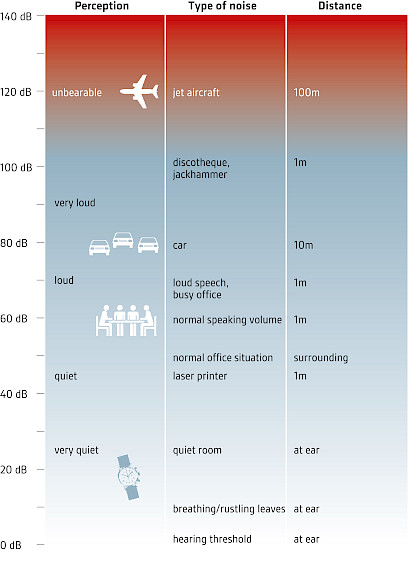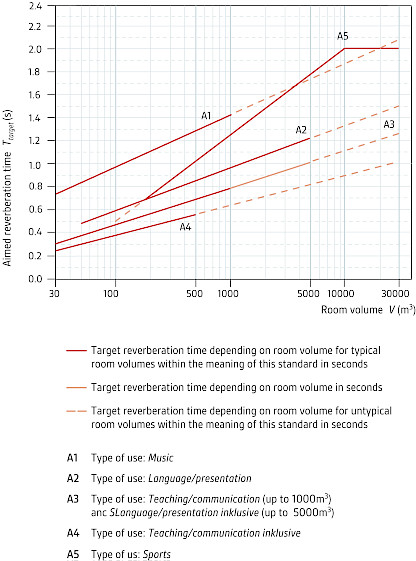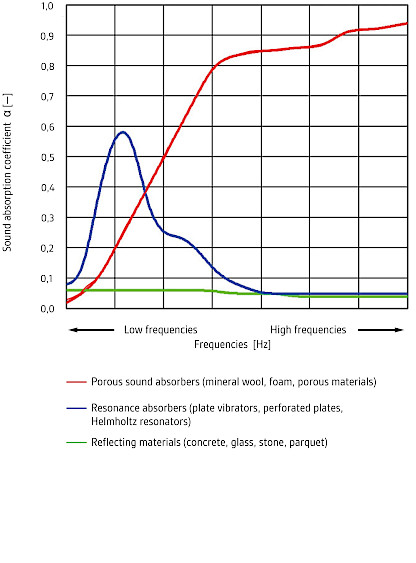Guest Author: Dr Christian Nocke, Akustikbüro Oldenburg
When we think about room design, we usually first consider the visual aspects of a space: the colours, shapes and surfaces of the floor, walls and ceiling. And of course, the furnishings, which significantly shape the character of a room.
However, it’s not just our eyes that perceive a space – our ears do too. We often only become aware of this when we’re disturbed by excessive noise levels, poor speech intelligibility, or other inadequate acoustic conditions. It’s usually then that the question arises: “Could this have been done better?” The answer in almost all cases is an unequivocal “Yes”, because room acoustics can be planned and predicted to a great extent. We also know the conditions under which people perceive rooms as acoustically pleasant – or disturbing.
In principle, every room can be optimally designed from an acoustic perspective. With the help of modern computer software, it is possible to calculate a room’s acoustics in great detail in advance. Such planning is always advisable, especially for spaces with high acoustic demands.
The goal is always to create a listening environment in which we feel comfortable, can communicate easily, and that does not feel too loud or too quiet.
Building Acoustics and Room Acoustics
The sections ‘Architectural Acoustics’ and ‘Room Acoustics’ deal with two completely different attributes of a building.
BUILDING ACOUSTICS
In building acoustics, the focus is on how much noise is transmitted from one room to another. In practice, this usually concerns adjacent or vertically connected rooms. If the building components involved (walls, ceilings, doors, windows) are not appropriately dimensioned or correctly installed, disturbances may occur within the building. For example, people may complain that conversations can be overheard from neighbouring rooms or that sounds from other areas intrude too strongly into their own space. Requirements for sound insulation in buildings are regulated legally by DIN 4109 “Sound insulation in buildings”, and also generally expected by clients – even in the absence of explicit contractual agreements.
In contrast, while there are well-established standards for room acoustics, such as DIN 18041 “Acoustic quality in rooms” or VDI 2569 “Sound insulation and acoustic design in offices”, these are advisory rather than legally binding. Thus, a contractual agreement should always include room acoustic considerations, as there is no statutory entitlement to appropriate room acoustics.
ROOM ACOUSTICS
Room acoustics always considers a room as a standalone entity: an office, call centre, meeting room, classroom, swimming pool, or concert hall. The focus lies on the acoustic conditions within the room itself, which are primarily determined by the surfaces and furnishings present.
Sound
We perceive sound events – such as noise, speech or music – as louder or quieter depending on their sound pressure level. Our perception of sound begins at around 20 dB (e.g. a ticking clock), while a whispered conversation typically reaches about 30 dB.
The key parameter used to describe noise exposure at a workplace is the so-called rating level (Lr), which is derived from the measured equivalent continuous sound level, adjusted by additions or subtractions depending on the characteristics and duration of the noise. Experience shows that from a rating level of 55 dB onwards, concentrated mental work becomes significantly more difficult. Therefore, sound levels in an office should ideally remain below this threshold to provide all employees with suitable working conditions.
During a normal conversation, we are exposed to a sound pressure level of around 60 dB. From a rating level of 80 dB, official guidelines for hearing protection start to apply, and beyond 100 dB, even relatively short exposure can cause irreversible hearing damage. Such levels may occur near pneumatic drills or jet engines – and sometimes even in nightclubs or at rock concerts (see Figure 1).
What We Perceive
In addition to sound pressure level, the frequency composition (or spectrum) of sound is especially important. The human ear typically perceives frequencies between approx. 20 Hz and 20,000 Hz. Music covers almost this entire range, whereas speech is largely limited to the range between 250 Hz and 2,000 Hz – where our hearing is most sensitive.
As a result of our ears’ varying sensitivity across frequencies, key acoustic parameters such as reverberation time, sound pressure level, and the sound absorption coefficient of a material are always specified in relation to frequency.
Technical standards also reflect the human hearing range. Building acoustics, concerned with sound transmission between rooms, typically considers frequencies from 100 Hz to 3,150 Hz. Room acoustic guidelines, on the other hand, usually refer to the range from 100 Hz to 5,000 Hz.
How a Room Sounds
The way a room sounds is primarily determined by its reverberation time. In simple terms, this is the time it takes for a sound to become inaudible after the source has stopped. Reverberation time is typically measured across the frequency range of 100 Hz to 5,000 Hz. The longest reverberation times, five seconds or more, are found in churches; the shortest, around 0.3 seconds or less, in recording studios or listening booths. The optimal reverberation time for a room depends on its size and use.
Our perception naturally expects longer reverberation in larger rooms than in smaller ones. If room size, use and reverberation time are not well-matched, users often feel disturbed and complaints are common. A room with too long a reverberation time may be described as echoey or boomy, whereas one with too short a reverberation time may be described as dry or muffled.
DIN 18041 addresses this by recommending that the ideal reverberation time increases with the volume of the room, depending on its intended use.
Reverberation Time
DIN 18041 provides guidance on reverberation times based on a room’s size and purpose.
For uses such as teaching and communication, the shortest reverberation times are recommended. Insufficient absorption – and therefore overly long reverberation – impairs speech intelligibility, which usually leads to speakers raising their voices. For spoken performances or music, longer reverberation times are recommended (see Figure 2).
Example: A 250 m² meeting room should have a reverberation time of 0.6 seconds.
Measurement Brings Clarity
Measuring reverberation time can reveal existing shortcomings objectively and provides a solid basis for improvement proposals. Based on the results, detailed design suggestions can be made, including suitable materials and the required surface area for optimal acoustic performance. The costs of measurement are often offset by more accurate specification of surface materials – avoiding over-engineering – and offer the assurance that any measures taken will actually be effective.
Sound Absorbers
Although there is a wide range of sound-absorbing materials available, they can all be traced back to two physical mechanisms: porous absorbers and resonant (or panel) absorbers.
POROUS ABSORBERS
Porous absorbers, such as mineral wool or foam, allow incoming sound to penetrate the material. The sound energy is converted into heat through friction within the pores, reducing the amount of sound reflected back.
RESONANT ABSORBERS
Resonant or panel absorbers are excited into vibration by incident sound – for example, a wooden or metal panel. This vibrational energy is also dissipated as heat through friction.
Porous absorbers are typically effective at mid to high frequencies with common thicknesses (10–20 cm). Resonant absorbers are usually tuned to low frequencies.
There are also hybrid types that combine both mechanisms, offering the advantage of broadband absorption across a wide frequency range.
Sound Absorption
The acoustic effectiveness of a material (or object) is described by its sound absorption coefficient. This value ranges from 0 (no absorption, e.g. a concrete wall) to 1 (complete absorption, e.g. wall surfaces in a recording studio). The absorption coefficient is highly frequency-dependent and should ideally be described not as a single number but as a set of values across the frequency range.
According to DIN EN ISO 354, the absorption coefficient is measured from 100 Hz to 5,000 Hz and denoted as αs. This results in values such as α100, α125, α160, … , α4000 , α5000, as shown in the curve in Figure 3. Each sound absorber thus has its own absorption “fingerprint”.
Absorption Within a Room
The amount of sound absorption in a room depends on both the surface area of materials and their respective absorption coefficients.
Multiplying the sound absorption coefficient αs of a surface absorber by its area S in the room gives the equivalent absorption area Aeq:
Aeq = αs x S.
This value represents the area of an ideal absorber (α = 1) with the same acoustic effect.
Example (at 500 Hz): 10 m² of material with αs = 0.52 results in Aeq = 5.2 m². This is equivalent to 20 m² of a material with αs = 0.26, or 5.2 m² of a perfect absorber (αs = 1).
A high absorption coefficient is not always necessary or desirable. Especially in larger rooms, the distribution of absorption is just as important as the total quantity.
For non-surface absorbers – such as furniture, partitions or other items – a method exists to determine the equivalent absorption area Aeq per element (e.g. per chair, partition, cupboard, etc.).
The total equivalent absorption area in a room is calculated by summing the values for all surfaces and objects, which allows for an estimate of the expected reverberation time.







